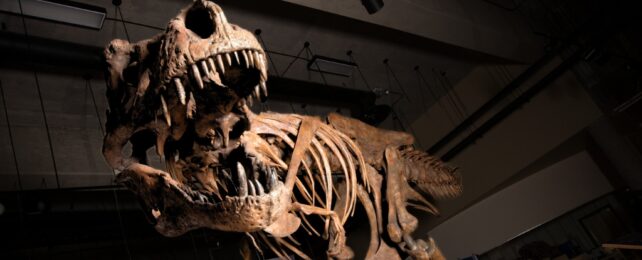If you select a random person out of a crowd, odds are they won't be the tallest human that ever lived. So why should we expect the same for dinosaurs?
Of all the Tyrannosaurus rex fossils we've found, it's statistically unlikely that any of them are the largest of their species to have lived. It's even difficult to gauge where they sit on the T. rex height chart.
A new study estimates that, statistically, the largest T. rex could have been 70 percent more massive than the largest specimen we have on record. That's a whopping weight of around 15,000 kg (30,000 pounds), compared to our largest fossil T. rex, Scotty, who is estimated to have tipped the scales at 8,800 kg when he died.
Paleobiologist Jordan Mallon from the Canadian Museum of Nature and paleontologist David Hone from Queen Mary University of London interrogate the issue that many life scientists face when trying to estimate the size range of a species based on a small sample of data.

As the team writes, "unless population sampling is both intensive and spatiotemporally exhaustive, it can be difficult to establish the upper limits of body size even for extant species."
Approximately 2.5 billion T. rexes are thought to have graced our planet in the species' short 2.4 million years, and yet so far we have only 84 reasonably complete skeletons to go off.
"Some isolated bones and pieces certainly hint at still larger individuals than for which we currently have skeletons," says Hone.
To fill in the gaps, Mallon and Hone generated 140 million virtual T. rex characters using a computer model that assigns body mass to each individual based on all the variables they could muster, including population size, growth rate, lifespan, and gaps in the fossil record.
This allowed them to estimate where the known fossil specimens would have stood on school photo day, if dinosaurs had those.
They found that we've likely already sampled a T. rex that is larger than 99 percent of all others that lived on Earth. The jury is still out on just how steep the curve is in that final 1 percent.
T. rex was chosen because it's a well-known species, for which many of those variables have been well-estimated.
But we don't know much about the king lizard's body size variation at adulthood, so the researchers turned to one of the dinosaur's closest living relatives, the American alligator (Alligator mississippiensis), as a reference point to account for the sizes of different sexes.
This may not be an ideal approximation. While that's the model in which a dinosaur 70 percent larger than Scotty outshines him, the authors note that the 15,000 kg maximum body mass estimate is more of a statistical fancy than a size we can be sure any T. rex actually reached.
Further research into the sexual dimorphism of T. rex and the biomechanical and ecological constraints on their body size may offer a clearer picture.
When it comes to the largest dinosaur contest, Mallon and Hone's research reminds us of the importance of comparing stats rather than skeletons.
"It's important to stress that this isn't really about T. rex, which is the basis of our study, but this issue would apply to all dinosaurs, and lots of other fossil species," says Hone.
"Arguing about 'which is the biggest?' based on a handful of skeletons really isn't very meaningful."
This research is published in Ecology and Evolution.
